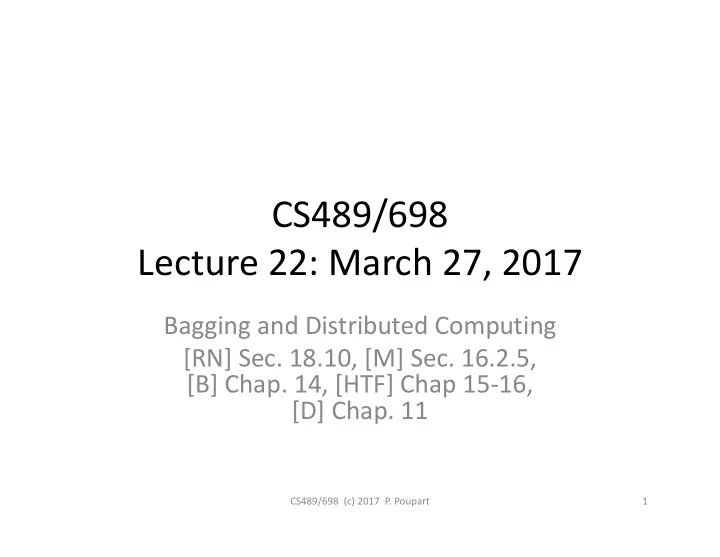

CS489/698 Lecture 22: March 27, 2017 Bagging and Distributed Computing [RN] Sec. 18.10, [M] Sec. 16.2.5, [B] Chap. 14, [HTF] Chap 15-16, [D] Chap. 11 CS489/698 (c) 2017 P. Poupart 1
Boosting vs Bagging • Review CS489/698 (c) 2017 P. Poupart 2
Independent classifiers/predictors • How can we obtain independent classifiers/predictors for bagging? • Bootstrap sampling – Sample (without replacement) subset of data • Random projection – Sample (without replacement) subset of features • Learn different classifiers/predictors based on each data subset and feature subset CS489/698 (c) 2017 P. Poupart 3
Bagging For k = 1 to K sample data subset sample feature subset train classifier/predictor based on and Classification: Regression: Random forest: bag of decision trees CS489/698 (c) 2017 P. Poupart 4
Application: Xbox 360 Kinect • Microsoft Cambridge • Body part recognition: supervised learning 5 CS489/698 (c) 2017 P. Poupart
Depth camera • Kinect Gray scale depth map Infrared image 6 CS489/698 (c) 2017 P. Poupart
Kinect Body Part Recognition • Problem: label each pixel with a body part 7 CS489/698 (c) 2017 P. Poupart
Kinect Body Part Recognition • Features: depth differences between pairs of pixels • Classification: forest of decision trees 8 CS489/698 (c) 2017 P. Poupart
Large Scale Machine Learning • Big data – Large number of data instances – Large number of features • Solution: distribute computation (parallel computation) – GPU (Graphics Processing Unit) – Many cores CS489/698 (c) 2017 P. Poupart 9
GPU computation • Many Machine Learning algorithms consist of vector, matrix and tensor operations – A tensor is a multidimensional array • GPU (Graphics Processing Units) can perform arithmetic operations on all elements of a tensor in parallel • Packages that facilitate ML programming on GPUs: TensorFlow, Theano, Torch, Caffe, DL4J CS489/698 (c) 2017 P. Poupart 10
Multicore Computation • Idea: Train a different classifier/predictor with a subset of the data on each core • How can we combine the classifiers/predictors? • Should we take the average of the parameters of the classifiers/predictors? No, this might lead to a worse classifier/predictor. This is especially problematic for models with hidden variables/units such as neural networks and hidden Markov models CS489/698 (c) 2017 P. Poupart 11
Bad case of parameter averaging • Consider two threshold neural networks that encode the exclusive-or Boolean function • Averaging the weights yields a new neural network that does not encode exclusive-or CS489/698 (c) 2017 P. Poupart 12
Safely Combining Predictions • A safe approach to ensemble learning is to combine the predictions (not the parameters) • Classification: majority vote of the classes predicted by the classifiers • Regression: average of the predictions computed by the regressors CS489/698 (c) 2017 P. Poupart 13
Recommend
More recommend